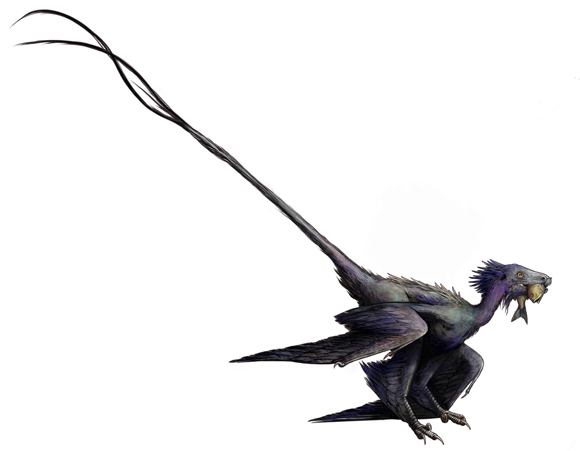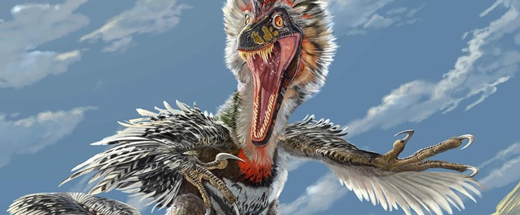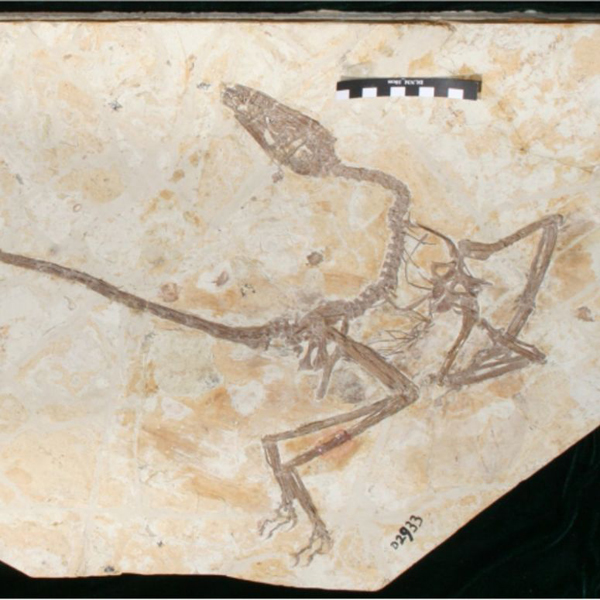The New Microraptorine Wulong bohaiensis
A new feathered dinosaur from Liaoning Province (north-eastern China), has been named and described. The little dinosaur, not much bigger than a crow, but with a long tail, has been named Wulong bohaiensis. The fossilised feathers associated with the beautifully preserved skeleton, include two long tail feathers, the sort of extravagant plumage associated with mature birds which use such adornments to attract a mate. However, when an analysis of the limb bones was undertaken to determine the age of the specimen (histological analysis), the research team discovered that the specimen represented a juvenile.
Either those long, showy feathers served some other function, or dinosaurs that were closely related to birds grew up differently when compared to their living relatives.
The Newly Described Wulong bohaiensis.
Picture credit: Ashley W. Poust (University of California)
Wulong bohaiensis – Dancing Dragon
The fossil specimen was found more than ten years ago by a local farmer. It had resided in the vertebrate collection of the Dalian Natural History Museum (Liaoning Province), being eventually described and studied by scientists at the museum in conjunction with student Ashley Poust under the supervision of Dr David Varricchio (Montana State University), her former advisor, prior to Ashley moving to the University of California.
The genus name is Chinese for “dancing dragon”, a reference to the posture of the preserved specimen. A phylogenetic analysis places W. bohaiensis within Microraptorinae, this little dinosaur was therefore closely related to Microraptor. Whether, like Microraptor, Wulong bohaiensis was capable of powered flight can be speculated upon.
Ashley Poust explained the significance of this research stating:
“The specimen has feathers on its limbs and tail that we associate with adult birds, but it had other features that made us think it was a juvenile.”
Studying the Histology of the Fossil Bones
In order to determine the age of the dinosaur when it died, staff at the Dalian Natural History Museum gave permission for the tibia, fibula and humerus bones to be examined histologically. Essentially, cross-sectional slices of these bones were removed from the skeleton, prepared and then examined under a microscope so that the seasonal/annual growth of the animal could be identified. Such a technique is invasive and will cause damage to the fossil specimen, fortunately, the curators at the Dalian Natural History Museum took the decision that in order to benefit science the invasive procedures had to be undertaken.
Ashley commented:
“Thankfully, our co-authors at the Dalian Natural History Museum were really forward thinking and allowed us to apply these techniques, not only to Wulong, but also to another dinosaur, a close relative that looked more adult called Sinornithosaurus.”
A Life Reconstruction of Wulong bohaiensis

Picture credit: Ashley Poust (University of California)
Sinornithosaurus Provides a Surprise
The histology of a specimen of another feathered dinosaur associated with the Early Cretaceous Jehol biota was also examined. The research team wanted to compare their immature, juvenile Wulong to what they thought was a specimen of an adult Sinornithosaurus. However, analysis of the bone structure of the Sinornithosaurus provided a surprise. The histology revealed that both specimens were young and still growing at death, indicating an age for Wulong of about one-year-old.
Commenting on the results of the histological analysis on the Sinornithosaurus specimen, Ashley explained:
“Here was an animal that was large and had adult looking bones. We thought it was going to be mature, but histology proved that idea wrong. It was older than Wulong, but seems to have been still growing. Researchers need to be really careful about determining whether a specimen is adult or not. Until we learn a lot more, histology is really the most dependable way.”
An Illustration of Sinornithosaurus

Picture Credit: Zhao Chuang
This new study suggests that either young dinosaurs developed elaborate tail feathers for some other purpose, or that they were growing feathers in a different way from their close living relatives the Aves (birds).
The Paraves Clade
The Paraves is a clade of theropod dinosaurs. It is defined as containing all the dinosaurs which are more closely related to birds than to oviraptorosaurs. As such it includes troodontids, dromaeosaurids and avialians, which encompasses extant birds. Much of what we know about the diversity of this group in the Early Cretaceous comes from fossil specimens found in Liaoning, China. However, many taxa are represented by specimens of unclear ontogenetic age.
With a better understanding of how dinosaurs may have changed in their appearance as they grew up, scientists can be more confident about their phylogeny, their evolutionary relationships and which character traits can be used to infer biology and the dinosaur’s position within the complex Jehol ecosystem.
This scientific paper identified several different types of feather associated with Wulong bohaiensis – pennaceous primary feathers, filamentous feathers and long tail feathers. The team established that such plumage preceded skeletal maturity and full adult size in some dromaeosaurids.
Histological analysis of the Wulong holotype and a Sinornithosaurus specimen revealed that they developed mature feather coverings associated with adult animals after their first year, but before they had become fully grown. This has implications for Paraves research as assumptions made about the adult age of a fossil specimen may not be accurate in the absence of histological analysis.
The scientific paper: “A new microraptorine theropod from the Jehol Biota and growth in early dromaeosaurids” by Ashley W. Poust, Chunling Gao, David J. Varricchio, Jianlin Wu, and Fengjiao Zhang published in The Anatomical Record.
The Everything Dinosaur website: Everything Dinosaur.







Leave A Comment